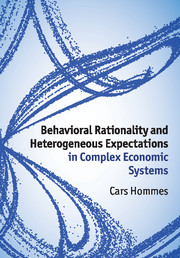Book contents
- Frontmatter
- Contents
- Figures
- Preface
- 1 Introduction
- 2 Bifurcations and chaos in 1-D systems
- 3 Bifurcations and strange attractors in 2-D systems
- 4 The nonlinear cobweb model
- 5 The cobweb model with heterogeneous expectations
- 6 An asset pricing model with heterogeneous beliefs
- 7 Empirical validation
- 8 Laboratory experiments
- Bibliography
- Index
6 - An asset pricing model with heterogeneous beliefs
Published online by Cambridge University Press: 05 February 2013
- Frontmatter
- Contents
- Figures
- Preface
- 1 Introduction
- 2 Bifurcations and chaos in 1-D systems
- 3 Bifurcations and strange attractors in 2-D systems
- 4 The nonlinear cobweb model
- 5 The cobweb model with heterogeneous expectations
- 6 An asset pricing model with heterogeneous beliefs
- 7 Empirical validation
- 8 Laboratory experiments
- Bibliography
- Index
Summary
In this chapter we present a financial market application of the heterogeneous expectations evolutionary switching framework of Brock and Hommes (1997a). This application has been termed adaptive belief systems (ABS), with beliefs and prices coevolving over time, and was introduced in Brock and Hommes (1998). An ABS is in fact a standard discounted value asset pricing model derived from mean-variance maximization, extended to the case of heterogeneous expectations.
The chapter is organized as follows. After introducing some basic assumptions of the model, we discuss the benchmark case of rational expectations and derive the fundamental price. In the following three sections, we then introduce heterogeneous beliefs, evolutionary selection of beliefs and the forecasting strategies. Section 6.5 discusses three typical few type examples: a 2-type example with costly fundamentalists versus chartists, a 3-type example with fundamentalists versus optimists and pessimists and a 4-type example with fundamentalists, biased traders and trend followers. All examples exhibit rational routes to randomness, that is, bifurcation routes to cycles and/or chaos as traders become more sensitive to differences in strategy performance. All examples illustrate how non-fundamental traders may survive evolutionary competition and that markets are characterized by bubble and crash dynamics. Section 6.6 discusses another 2-type example with fundamentalists versus conditional trend followers, who condition their trend-following strategy upon deviations from the fundamental. This example exhibits coexisting attractors, as a stable fundamental steady state may coexist with a stable limit cycle or even a strange attractor. In the presence of small noise, the model then exhibits clustered volatility, with irregular switching between close to the fundamental price fluctuations with fundamentalists dominating the market and phases of large price swings amplified by trend followers. Finally, Section 6.7 discusses the case with many different trading strategies and presents the notion of large type limit, a simple low-dimensional system approximating an evolutionary market with many trader types.
- Type
- Chapter
- Information
- Publisher: Cambridge University PressPrint publication year: 2013



